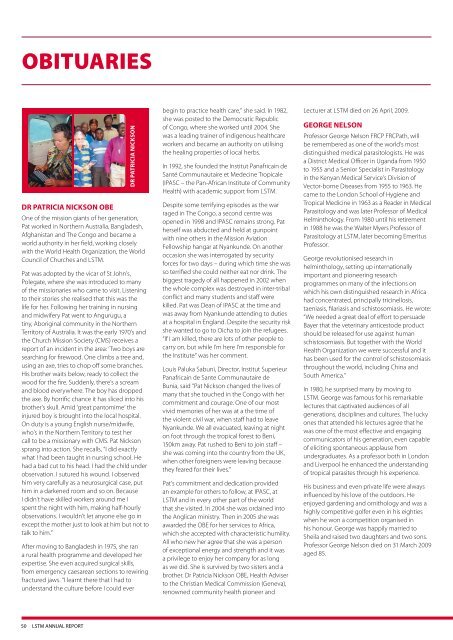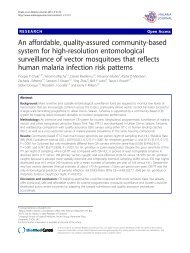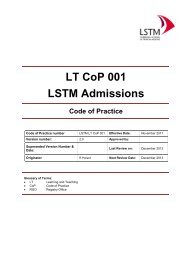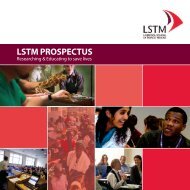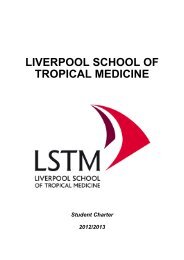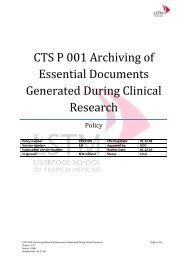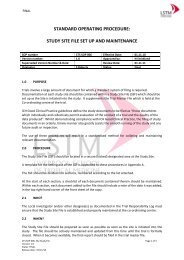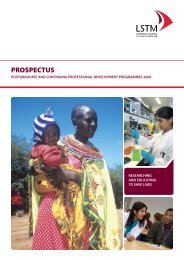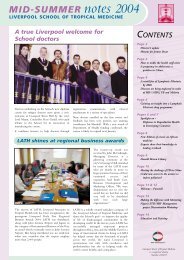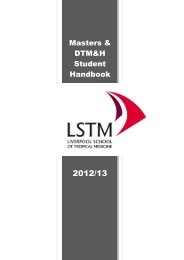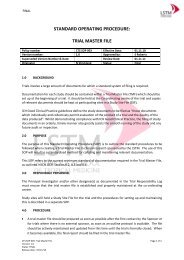Annual Report 2008 - 2009 - Liverpool School of Tropical Medicine
Annual Report 2008 - 2009 - Liverpool School of Tropical Medicine
Annual Report 2008 - 2009 - Liverpool School of Tropical Medicine
You also want an ePaper? Increase the reach of your titles
YUMPU automatically turns print PDFs into web optimized ePapers that Google loves.
Obituaries<br />
Dr Patricia Nickson OBE<br />
Dr Patricia Nickson<br />
One <strong>of</strong> the mission giants <strong>of</strong> her generation,<br />
Pat worked in Northern Australia, Bangladesh,<br />
Afghanistan and The Congo and became a<br />
world authority in her field, working closely<br />
with the World Health Organization, the World<br />
Council <strong>of</strong> Churches and LSTM.<br />
Pat was adopted by the vicar <strong>of</strong> St John’s,<br />
Polegate, where she was introduced to many<br />
<strong>of</strong> the missionaries who came to visit. Listening<br />
to their stories she realised that this was the<br />
life for her. Following her training in nursing<br />
and midwifery Pat went to Angurugu, a<br />
tiny, Aboriginal community in the Northern<br />
Territory <strong>of</strong> Australia. It was the early 1970’s and<br />
the Church Mission Society (CMS) receives a<br />
report <strong>of</strong> an incident in the area: ‘Two boys are<br />
searching for firewood. One climbs a tree and,<br />
using an axe, tries to chop <strong>of</strong>f some branches.<br />
His brother waits below, ready to collect the<br />
wood for the fire. Suddenly, there’s a scream<br />
and blood everywhere. The boy has dropped<br />
the axe. By horrific chance it has sliced into his<br />
brother’s skull. Amid ‘great pantomime’ the<br />
injured boy is brought into the local hospital.<br />
On duty is a young English nurse/midwife,<br />
who’s in the Northern Territory to test her<br />
call to be a missionary with CMS. Pat Nickson<br />
sprang into action. She recalls, “I did exactly<br />
what I had been taught in nursing school. He<br />
had a bad cut to his head. I had the child under<br />
observation. I sutured his wound. I observed<br />
him very carefully as a neurosurgical case, put<br />
him in a darkened room and so on. Because<br />
I didn’t have skilled workers around me I<br />
spent the night with him, making half-hourly<br />
observations. I wouldn’t let anyone else go in<br />
except the mother just to look at him but not to<br />
talk to him.”<br />
After moving to Bangladesh in 1975, she ran<br />
a rural health programme and developed her<br />
expertise. She even acquired surgical skills,<br />
from emergency caesarean sections to rewiring<br />
fractured jaws. “I learnt there that I had to<br />
understand the culture before I could ever<br />
begin to practice health care,” she said. In 1982,<br />
she was posted to the Democratic Republic<br />
<strong>of</strong> Congo, where she worked until 2004. She<br />
was a leading trainer <strong>of</strong> indigenous healthcare<br />
workers and became an authority on utilising<br />
the healing properties <strong>of</strong> local herbs.<br />
In 1992, she founded the Institut Panafricain de<br />
Santé Communautaire et Medecine <strong>Tropical</strong>e<br />
(IPASC – the Pan-African Institute <strong>of</strong> Community<br />
Health) with academic support from LSTM.<br />
Despite some terrifying episodes as the war<br />
raged in The Congo, a second centre was<br />
opened in 1998 and IPASC remains strong. Pat<br />
herself was abducted and held at gunpoint<br />
with nine others in the Mission Aviation<br />
Fellowship hangar at Nyankunde. On another<br />
occasion she was interrogated by security<br />
forces for two days – during which time she was<br />
so terrified she could neither eat nor drink. The<br />
biggest tragedy <strong>of</strong> all happened in 2002 when<br />
the whole complex was destroyed in inter-tribal<br />
conflict and many students and staff were<br />
killed. Pat was Dean <strong>of</strong> IPASC at the time and<br />
was away from Nyankunde attending to duties<br />
at a hospital in England. Despite the security risk<br />
she wanted to go to Oicha to join the refugees.<br />
“If I am killed, there are lots <strong>of</strong> other people to<br />
carry on, but while I’m here I’m responsible for<br />
the Institute” was her comment.<br />
Louis Paluka Sabuni, Director, Institut Superieur<br />
Panafricain de Sante Communautaire de<br />
Bunia, said “Pat Nickson changed the lives <strong>of</strong><br />
many that she touched in the Congo with her<br />
commitment and courage. One <strong>of</strong> our most<br />
vivid memories <strong>of</strong> her was at a the time <strong>of</strong><br />
the violent civil war, when staff had to leave<br />
Nyankunde. We all evacuated, leaving at night<br />
on foot through the tropical forest to Beni,<br />
150km away. Pat rushed to Beni to join staff –<br />
she was coming into the country from the UK,<br />
when other foreigners were leaving because<br />
they feared for their lives.”<br />
Pat’s commitment and dedication provided<br />
an example for others to follow, at IPASC, at<br />
LSTM and in every other part <strong>of</strong> the world<br />
that she visited. In 2004 she was ordained into<br />
the Anglican ministry. Then in 2005 she was<br />
awarded the OBE for her services to Africa,<br />
which she accepted with characteristic humility.<br />
All who new her agree that she was a person<br />
<strong>of</strong> exceptional energy and strength and it was<br />
a privilege to enjoy her company for as long<br />
as we did. She is survived by two sisters and a<br />
brother. Dr Patricia Nickson OBE, Health Adviser<br />
to the Christian Medical Commission (Geneva),<br />
renowned community health pioneer and<br />
Lecturer at LSTM died on 26 April, <strong>2009</strong>.<br />
George Nelson<br />
Pr<strong>of</strong>essor George Nelson FRCP FRCPath, will<br />
be remembered as one <strong>of</strong> the world’s most<br />
distinguished medical parasitologists. He was<br />
a District Medical Officer in Uganda from 1950<br />
to 1955 and a Senior Specialist in Parasitology<br />
in the Kenyan Medical Service’s Division <strong>of</strong><br />
Vector-borne Diseases from 1955 to 1963. He<br />
came to the London <strong>School</strong> <strong>of</strong> Hygiene and<br />
<strong>Tropical</strong> <strong>Medicine</strong> in 1963 as a Reader in Medical<br />
Parasitology and was later Pr<strong>of</strong>essor <strong>of</strong> Medical<br />
Helminthology. From 1980 until his retirement<br />
in 1988 he was the Walter Myers Pr<strong>of</strong>essor <strong>of</strong><br />
Parasitology at LSTM, later becoming Emeritus<br />
Pr<strong>of</strong>essor.<br />
George revolutionised research in<br />
helminthology, setting up internationally<br />
important and pioneering research<br />
programmes on many <strong>of</strong> the infections on<br />
which his own distinguished research in Africa<br />
had concentrated, principally tricinellosis,<br />
taeniasis, filariasis and schistosomiasis. He wrote:<br />
“We needed a great deal <strong>of</strong> effort to persuade<br />
Bayer that the veterinary anticestode product<br />
should be released for use against human<br />
schistosomiasis. But together with the World<br />
Health Organization we were successful and it<br />
has been used for the control <strong>of</strong> schistosomiasis<br />
throughout the world, including China and<br />
South America.”<br />
In 1980, he surprised many by moving to<br />
LSTM. George was famous for his remarkable<br />
lectures that captivated audiences <strong>of</strong> all<br />
generations, disciplines and cultures. The lucky<br />
ones that attended his lectures agree that he<br />
was one <strong>of</strong> the most effective and engaging<br />
communicators <strong>of</strong> his generation, even capable<br />
<strong>of</strong> eliciting spontaneous applause from<br />
undergraduates. As a pr<strong>of</strong>essor both in London<br />
and <strong>Liverpool</strong> he enhanced the understanding<br />
<strong>of</strong> tropical parasites through his experience.<br />
His business and even private life were always<br />
influenced by his love <strong>of</strong> the outdoors. He<br />
enjoyed gardening and ornithology and was a<br />
highly competitive golfer even in his eighties<br />
when he won a competition organised in<br />
his honour. George was happily married to<br />
Sheila and raised two daughters and two sons.<br />
Pr<strong>of</strong>essor George Nelson died on 31 March <strong>2009</strong><br />
aged 85.<br />
50 LSTM ANNUAL REPORT


